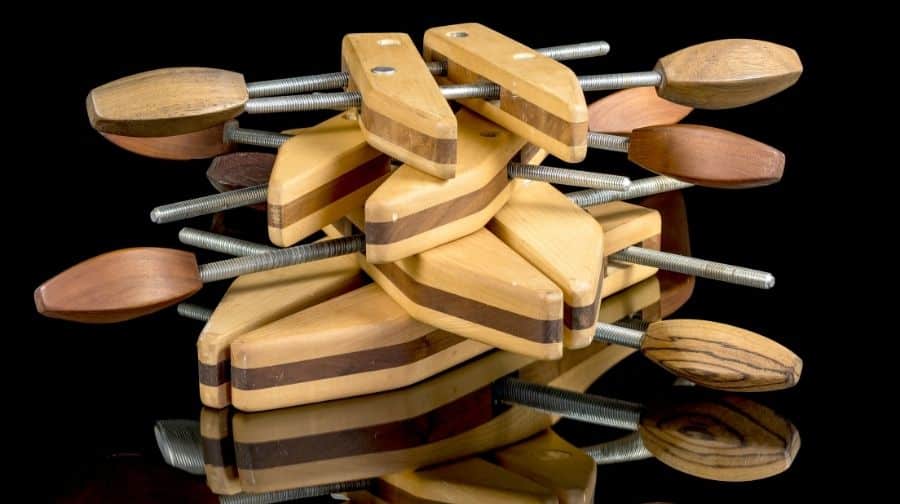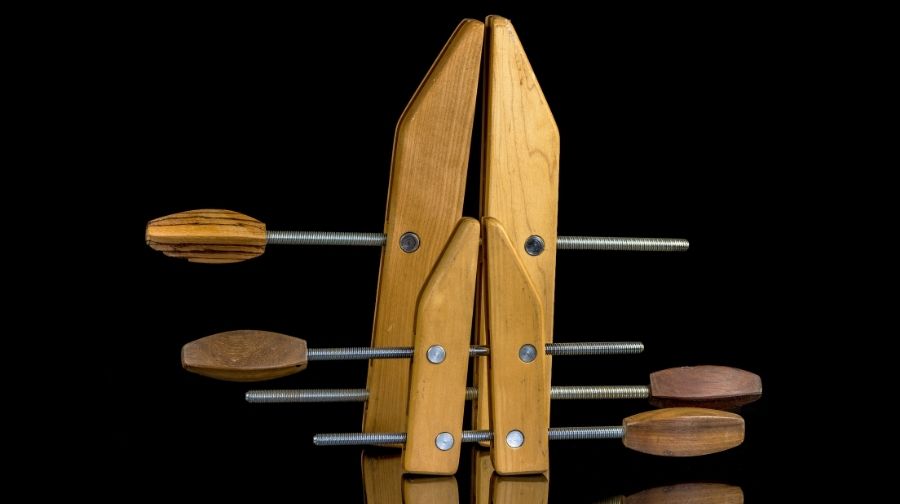
What Is A Screw Clamp?
A screw clamp is a mechanical device used for holding onto workpieces while other operations are being taken out on them. Screw clamps are called that because they employ a screw mechanism to adjust the jaws and clamp the workpiece in place.
Screw clamp, is the general term that is used to describe a group of clamps that use the screw mechanism to clamp a workpiece in place. Screw clamps are strong and sturdy fastening devices, hence once the screw is in position, a lot of force is needed to accidentally or purposely loosen it. It is due to this strength in the tightening that screw clamps are so popular among woodworkers and DIYers alike.
Types of Screw Clamps
The G Clamp:
The G clamp or C clamp is a kind of screw clamp that takes the shape of the letter G when the screw is attached, and a C when it is not. The G clamp shares common characteristics with the other screw clamps as it uses the flat end of the screw as a moveable jaw.
The F Clamp:
This type of screw clamp is so-called because it is shaped just like the letter F. The F clamp, unlike the G clamp has a jaw that can slide up and down, as well as the screw sliding, either to tighten or loosen around the workpiece.
The Edging Clamp:
The edging clamp was designed as a solution for specific special and difficult tasks that could not be performed as efficiently by other clamps. These works usually involve edge banding being applied to the side of a surface. This clamp is perfect for projects involving edge banding as this can be quite difficult to complete.
Wooden Hand Screw Clamps:
The wooden hand screw clamp is a large woodworking clamp that is mostly used for applications that involve delicate wood workpieces. This is because this clamp is made of wood, which is naturally a softer material than metal so it has a much lower chance of marring or damaging the wood while clamping it.
The Rack Clamp:
A rack clamp is a tool that is specially designed for clamping metals. It is a very strong and durable type of clamp so it can easily withstand huge amounts of pressure on both the heavy and light scales. The rack clamp can be used for many different types of metalworking such as welding, pattern making, metal fabrication, die holding, molding, and machining.
Handle Screw Clamp
A handle screw clamp is a hand tool used to secure a workpiece by applying inward pressure from one or more screws. The handle is usually an L-shaped lever that is turned to tighten the clamp. Handle screw clamps are often used in woodworking and metalworking applications.
There are many different types of handle screw clamps, but they all operate on the same principle. The clamping force is generated by turning the handle, which tightens the screw(s). The workpiece is then held in place by the clamping force.
Metal Screw Clamp
A metal screw clamp is a handy tool to have around the house. You can use it to clamp down on a piece of wood or metal while you drill a hole in it. This will keep the piece from moving around while you work.
You can also use a metal screw clamp to hold two pieces of wood together while you glue them. This is especially helpful when you are working with large pieces of wood. The clamp will hold the wood in place while the glue dries.
If you need to make a quick repair, a metal screw clamp can also be used to hold two pieces of metal together. This is especially helpful for pipes or other metal objects that are difficult to solder.
Although there are several kinds of screw clamps, they all generally comprise the same features. These features include:
The jaws: The clamp’s jaws are a common factor among the screw clamps. All types of screw clamps possess several jaws (usually 2, but sometimes more). One of these jaws is stationary and fixed while the other is moveable and these jaws serve the major purpose of holding onto and securing the workpiece.
Sometimes, the clamping faces of these jaws (the part of the jaw that comes in contact with the workpiece) need to be covered with pads to prevent the workpiece from being marred or damaged. In other situations, pieces of scrap wood are put in between the clamping face and the workpiece to prevent any form of damage.
The screw: All types of screw clamps possess a screw because, as the name implies, it serves a very important purpose. The screw usually serves as the component that tightens the moveable jaw onto the workpiece by being turned in a clockwise direction.
The screw is usually a helical thread screw and this ensures more strength and durability when it comes to holding onto the workpiece. The screw can easily be turned in the opposite direction if it needs to be loosened.
The frame: This is the biggest part of the screw clamp as it covers the most area. It is the part that connects the jaws as well as all the other parts. The frame could be a straight horizontal bar or could have a special shape, all depending on the kind of screw clamp that is in use.
The frame of the screw clamp is usually made of an incredibly strong metal to make sure it can withstand the immense pressure that it would be put under by the workpiece that is being clamped.
The handle: This is the part of the clamp that is attached to the screw. It is attached to help with the smooth and easy tightening and loosening of the screw on the clamp. The handle of the clamp is created to be normally operated using just one hand while the other hand is used to perform other operations on the workpiece.
Are Wooden Hand Screw Clamps Worth Anything
Subscribe to Wood By Wright on Youtube
Other parts of the screw clamp could include:
a) The spring lock
b) The tilting jaw
c) The lever
d) The slot
e) The collar
Screw clamps are portable and extremely versatile as they can be used in almost any situation that they are needed for. To use a screw clamp, you need to follow a couple of simple steps:
Open the jaws: To use a screw clamp or any clamp for that matter, you would first need to open up the jaws of the clamp. You should do this by twisting the handle in an anti-clockwise direction so the screw can be loosened and the moveable jaw can be slid away from the stationary jaw. If your screw clamp has more than one handle, each one will need to be twisted individually so all the jaws can be opened.
Position the clamp: You should then place your clamp where you intend to use it on the workpiece, Place the clamp over the workpiece, with each jaw holding on to each side of the piece and sitting opposite each other.
Close the jaws: Once you have positioned the jaws around the workpiece, then you should simply turn the handle in the clockwise direction to tighten the jaws around the workpiece and firmly secure it.
Remember to take proper care of your screw clamp by oiling the moveable parts frequently and ensure you use multiple screw clamps on large workpieces.

